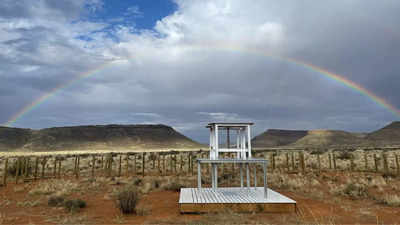- News
- City News
- mumbai News
- Global team with two TIFR scientists develops novel way to ‘detect’ 1st stars
Trending
This story is from July 22, 2022
Global team with two TIFR scientists develops novel way to ‘detect’ 1st stars
mumbai an international team of 40 researchers including two from tifr have developed a unique methodology to detect light from the first stars and galaxies from the early universe the technique is significant claim the researchers as it is their best chance to detect the cosmological signals coming from the first stars’ the collaboration under the reach radio experiment for the analysis of cosmic hydrogen project also will complement global efforts in studying the formation of the cosmic hydrogen project.

REACH hexagonal dipole radio antenna installed in the Karoo radio reserve in South Africa. (Image - The REACH collaboration)
Observing the birth of the first stars and galaxies has been a goal of astronomers for years, as it will help explain how the Universe evolved from the emptiness after the Big Bang. “At the time when the first stars formed, the Universe was mostly empty and composed mostly of hydrogen and helium,” said Dr Eloy de Lera Acedo from Cambridge’s Cavendish Laboratory, the lead author of the paper reported in the Nature Astronomy journal on Thursday. “Because of gravity, the elements came together, and the conditions were right for nuclear fusion, which is what formed the first stars. But they were surrounded by clouds of neutral hydrogen, which absorb light really well, so it is hard to detect or observe the light directly,” he said, in a statement.
The cosmological signals that astronomers aim to detect, to study the birth of lights, are weaker than the other radio signals coming from the sky. As using a radio telescope itself introduces instrument-related distortions, the REACH team introduced two modifications in the traditional methods. “We used two types of dissimilar telescopes in the field instead of one, and we use an end-to-end Bayesian statistical technique to separate the cosmological signal from the rest of the sky and any instrumental effects,” said Girish Kulkarni from TIFR, who is part of the team. Kulkarni and his PhD student Shikhar Mittal are part of the theoretical component of the group.
“The idea of using two telescopes of different shapes, sizes and properties, was to rule out any instrumental artefacts from the cosmological signal,” said Kulkarni, adding that the idea worked on simulations. The paper published in Nature Astronomy shows that the method will have a chance to detect the cosmological signal reliably. The first observations from REACH are expected in about six to 12 months.
The genesis of the project lay in the results published by a group of American scientists running the Experiment to Detect the Global Epoch of Reionization Signature (EDGES) project, which did not fit our expectations from our understanding of how the universe works, said Kulkarni. He and his collaborators realised that the correct way to understand their data was to carry out the whole experiment independently. Karoo Radio Reserve in South Africa was chosen for the location to construct the telescope, as it has excellent conditions for radio observations.
Kulkarni said that it is an important and exciting breakthrough for the scientific community at a time when the new James Webb Space Telescope (JWST) now, and the Square Kilometre Array, a next-generation telescope, in 10 years, is likely to make images of the earliest light in the Universe. SKA is a two-billion-dollar project with participation from 10 countries, including India.
End of Article
FOLLOW US ON SOCIAL MEDIA










